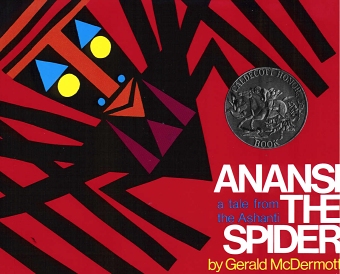| THE TOP TEN HERO BUGS - PART TWO |
| #5 - The Cast of James and the Giant Peach |
Like "A Bug's Life," there's no single buggy hero of Road Dahl's 1961 children's novel, but its ensemble cast of
magically enlarged invertebrates act as a loving and courageous family to the titular character, whose original
parents were supposedly eaten by a rhinoceros. Living with his horribly abusive aunts when the story begins,
James is given a bag of magic by a mysterious stranger and accidentally spills it on a peach tree, enlarging
one of its fruit to the size of a house and an assortment of tiny creatures to mostly human-size, including a
tough-talking centipede, a worry-wart earthworm, a high-society grasshopper, a spider, a ladybug, a glowworm
and a silkworm. Together, they take the peach on a journey through exotic locales and encounter all manner
of strange, dangerous adversaries.
magically enlarged invertebrates act as a loving and courageous family to the titular character, whose original
parents were supposedly eaten by a rhinoceros. Living with his horribly abusive aunts when the story begins,
James is given a bag of magic by a mysterious stranger and accidentally spills it on a peach tree, enlarging
one of its fruit to the size of a house and an assortment of tiny creatures to mostly human-size, including a
tough-talking centipede, a worry-wart earthworm, a high-society grasshopper, a spider, a ladybug, a glowworm
and a silkworm. Together, they take the peach on a journey through exotic locales and encounter all manner
of strange, dangerous adversaries.
| #3 - Maya the Bee |
I spent a significant portion of my childhood watching Maya's Japanese animated adventures on "Nick Junior"
and I'm certainly not alone, but the character was actually born from a German children's book written by
Waldemar Bonsels and published in 1912. In the original tale, Maya is an immature worker honeybee who
commits the unforgivable crime of abandoning her colony for a life of freedom. After many hardships, Maya is
taken prisoner by Hornets who are plotting the invasion of her hive. Narrowly escaping, she is forced to choose
between herself and the very bees who exiled her, as she must warn her people but is due to be punished if
she ever returns. Forgiven for her bravery, Maya is welcomed back into society and eventually becomes a
teacher.
and I'm certainly not alone, but the character was actually born from a German children's book written by
Waldemar Bonsels and published in 1912. In the original tale, Maya is an immature worker honeybee who
commits the unforgivable crime of abandoning her colony for a life of freedom. After many hardships, Maya is
taken prisoner by Hornets who are plotting the invasion of her hive. Narrowly escaping, she is forced to choose
between herself and the very bees who exiled her, as she must warn her people but is due to be punished if
she ever returns. Forgiven for her bravery, Maya is welcomed back into society and eventually becomes a
teacher.
| #4 - The Highly Magnified and Thoroughly Educated Wogglebug (Oz books) |
Created by the beloved Frank L. Baum for his 1904 book "The Marvelous Land of Oz," H.M. Wogglebug
began as only a pea-sized, garden variety insect and obtained his "thorough education" through years of
eavesdropping on a human schoolhouse, until he was caught by the teacher and projected through a
microscope for a biology lesson. Thanks to the preposterous physics of Oz (I think that was even the name of
another book. Wasn't it? No? Well, it should have been), the little bug was simply able to hop off the projector
at his magnified size, and thus he remained.
began as only a pea-sized, garden variety insect and obtained his "thorough education" through years of
eavesdropping on a human schoolhouse, until he was caught by the teacher and projected through a
microscope for a biology lesson. Thanks to the preposterous physics of Oz (I think that was even the name of
another book. Wasn't it? No? Well, it should have been), the little bug was simply able to hop off the projector
at his magnified size, and thus he remained.
| #2 - Charlotte (Charlotte's Web) |
One of the most treasured works of literature in America and among the best-selling children's books in the
world, E. B. White's 1952 Charlotte's Web tells the simple, bittersweet story of a pig named wilbur who
befriends a female spider. By writing a series of messages in her web, this amazingly literate arachnid
convinces Wilbur's owners that the pig is too special to end up on the dinner table, and as a tiny
garden-variety spider, the effort to save her new friend from the slaughterhouse occupies most of Charlotte's
natural lifespan. It's the smallest act of heroism on this entire list, but one that can bring readers of all ages to
tears. If your fear of spiders doesn't even slightly diminish after reading this book, your heart must be a
miserable, blackened wad. A wad I say.
IN THE REAL WORLD: as demonstrated in the book, newly hatched spiders of many species will release a
strand of silk into the wind and "fly" to new locations. This behavior is scientifically known as "ballooning," and
most spiders will employ the trick but once in their lifespan.
world, E. B. White's 1952 Charlotte's Web tells the simple, bittersweet story of a pig named wilbur who
befriends a female spider. By writing a series of messages in her web, this amazingly literate arachnid
convinces Wilbur's owners that the pig is too special to end up on the dinner table, and as a tiny
garden-variety spider, the effort to save her new friend from the slaughterhouse occupies most of Charlotte's
natural lifespan. It's the smallest act of heroism on this entire list, but one that can bring readers of all ages to
tears. If your fear of spiders doesn't even slightly diminish after reading this book, your heart must be a
miserable, blackened wad. A wad I say.
IN THE REAL WORLD: as demonstrated in the book, newly hatched spiders of many species will release a
strand of silk into the wind and "fly" to new locations. This behavior is scientifically known as "ballooning," and
most spiders will employ the trick but once in their lifespan.
| #1 - Anansi the Spider (African Mythology) |
Anansi is often said to carry out his father's will on Earth, bringing rain to quench fire or end drought. He has
even been said in some stories to have even created the sun, stars and moon. Others say it was Anansi who
set civilization in motion by imparting his wisdom on early man, teaching us the basic principles of agriculture or
toolkmaking.
Demonstrating unparalleled failure at mythology and typical western bias against spiders, Anansi has been
portrayed as a demonic supernatural villain more than once in popular culture, including Disney's animated
series "Gargoyles" and within the DC comics universe. Whatever you watch, whatever you read, don't mistake
this celebrated folk hero for just another eight-legged monster.
IN THE REAL WORLD: spiders are some of the natural world's most successful predators and a major form of
insect population control. Were they to suddenly vanish, flies and mosquitoes could darken the skies in a
matter of months.
even been said in some stories to have even created the sun, stars and moon. Others say it was Anansi who
set civilization in motion by imparting his wisdom on early man, teaching us the basic principles of agriculture or
toolkmaking.
Demonstrating unparalleled failure at mythology and typical western bias against spiders, Anansi has been
portrayed as a demonic supernatural villain more than once in popular culture, including Disney's animated
series "Gargoyles" and within the DC comics universe. Whatever you watch, whatever you read, don't mistake
this celebrated folk hero for just another eight-legged monster.
IN THE REAL WORLD: spiders are some of the natural world's most successful predators and a major form of
insect population control. Were they to suddenly vanish, flies and mosquitoes could darken the skies in a
matter of months.
Maya's animated series lifted many sequences directly from the book, but expanded far longer into dozens of
adventures in the insect world, featuring some admirably accurate science that unfortunately suffered its share
of translation error; the English versions often confused centipedes with millipedes, larvae with pupa and even
cicadas with crickets. Regardless, the original writers and animators really knew their stuff, and spun some of
the world's most fascinating arthropods into all manner of dilemmas for Maya to face. In one memorable
episode, Maya encounters a mother fly whose adorable baby maggot turns out to be a bloodthirsty parasite,
preying on the young of a tunnel-digging wasp. Enlisting the help of an earthworm, Maya and the Wasp build
so many decoy tunnels that the fly is forced to give up her hunt for the eggs. In other, she believes that the
eggs being carried by a large, male insect have been stolen, unaware that male waterbugs naturally carry the
young. Despite her size and naivette, Maya was always willing to put her life on the line for fellow creatures
large and small, even coming to the aid of human children on more than one occassion.
IN THE REAL WORLD: many hornets, especially the Asian Giant Hornet, will indeed send "raiding parties" to
attack the nests of smaller, weaker honeybees, collecting the honey and feeding the helpless bee larvae to
their own young. Fortunately, native Japanese honeybees have adapted an ingenious defense against these
monsters; when a hornet is detected, the bees cover the larger insect with their bodies in a solid "bee ball" and
heat up their bodies. With a slightly higher tolerance for heat than the hornet, their enemy is literally cooked to
death.
adventures in the insect world, featuring some admirably accurate science that unfortunately suffered its share
of translation error; the English versions often confused centipedes with millipedes, larvae with pupa and even
cicadas with crickets. Regardless, the original writers and animators really knew their stuff, and spun some of
the world's most fascinating arthropods into all manner of dilemmas for Maya to face. In one memorable
episode, Maya encounters a mother fly whose adorable baby maggot turns out to be a bloodthirsty parasite,
preying on the young of a tunnel-digging wasp. Enlisting the help of an earthworm, Maya and the Wasp build
so many decoy tunnels that the fly is forced to give up her hunt for the eggs. In other, she believes that the
eggs being carried by a large, male insect have been stolen, unaware that male waterbugs naturally carry the
young. Despite her size and naivette, Maya was always willing to put her life on the line for fellow creatures
large and small, even coming to the aid of human children on more than one occassion.
IN THE REAL WORLD: many hornets, especially the Asian Giant Hornet, will indeed send "raiding parties" to
attack the nests of smaller, weaker honeybees, collecting the honey and feeding the helpless bee larvae to
their own young. Fortunately, native Japanese honeybees have adapted an ingenious defense against these
monsters; when a hornet is detected, the bees cover the larger insect with their bodies in a solid "bee ball" and
heat up their bodies. With a slightly higher tolerance for heat than the hornet, their enemy is literally cooked to
death.
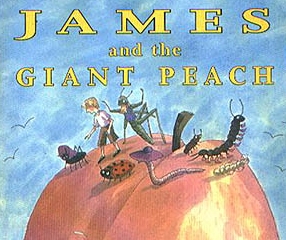
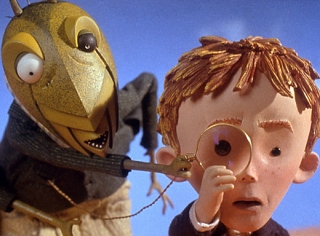
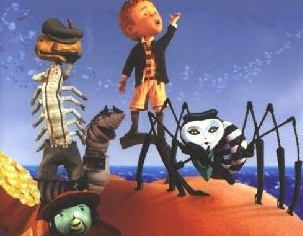
In 1996, the story was adapted to film for the first time by animation director Henry Selick, who previously
directed The Nightmare Before Christmas. The film crunches down the story, omits the (admittedly incidental)
silkworm, tones down a few of the book's darker themes and inserts some rather uninspired musical numbers,
but it's still a cool, charming story presented with some truly inspired art direction. Jack Skellington's
stop-motion model is even recycled as an undead pirate!
directed The Nightmare Before Christmas. The film crunches down the story, omits the (admittedly incidental)
silkworm, tones down a few of the book's darker themes and inserts some rather uninspired musical numbers,
but it's still a cool, charming story presented with some truly inspired art direction. Jack Skellington's
stop-motion model is even recycled as an undead pirate!
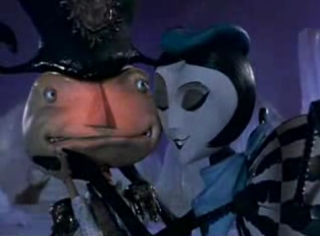
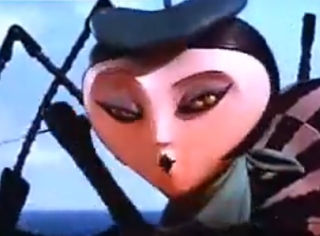
...And is it just me, or is that not the sexiest damn spider you've ever seen? Maybe it's me. Maybe I just need to
get out of the house once in a while.
IN THE REAL WORLD: of the whole cast, only the grasshopper, silkworm and earthworm might conceivably
feed from a peach or other vegetable matter. Centipedes and spiders are opportunistic predators, ladybugs
are predators of plant lice, and glowworms prey on slugs and snails.
get out of the house once in a while.
IN THE REAL WORLD: of the whole cast, only the grasshopper, silkworm and earthworm might conceivably
feed from a peach or other vegetable matter. Centipedes and spiders are opportunistic predators, ladybugs
are predators of plant lice, and glowworms prey on slugs and snails.
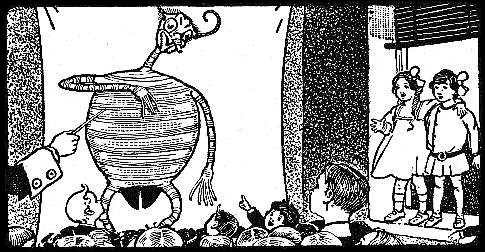
In his first appearance, the bug is portrayed as an eccentric but kind-hearted intellectual, rescuing his friends
from assorted dangers and selflessly coming to the aid of others in subsequent spin-off stories. As a reward
for his bravery, H.M. is even appointed the professor of his very own academy in the Emerald City. Sadly, the
bug's heroism seems to have been short lived. He seldom appeared in Baum's later books, and was described
by other characters as a pompous, conceited individual. When author Ruth Plumly Thompson took over the
series in 1921, she rewrote the bug as a flat-out rat bastard. What the hell was your problem, Ruth!?
from assorted dangers and selflessly coming to the aid of others in subsequent spin-off stories. As a reward
for his bravery, H.M. is even appointed the professor of his very own academy in the Emerald City. Sadly, the
bug's heroism seems to have been short lived. He seldom appeared in Baum's later books, and was described
by other characters as a pompous, conceited individual. When author Ruth Plumly Thompson took over the
series in 1921, she rewrote the bug as a flat-out rat bastard. What the hell was your problem, Ruth!?
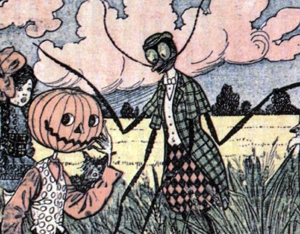
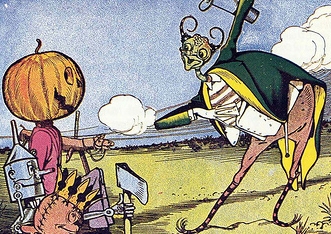
IN THE REAL WORLD: though frequently used as a blanket term for armored invertebrates, the word "bug"
only properly applies to insects of the order Hemiptera. Fortunately, Wogglebug does share some key
characteristics of a “true bug,” including a large beetle-like body and a pointed snout.
only properly applies to insects of the order Hemiptera. Fortunately, Wogglebug does share some key
characteristics of a “true bug,” including a large beetle-like body and a pointed snout.
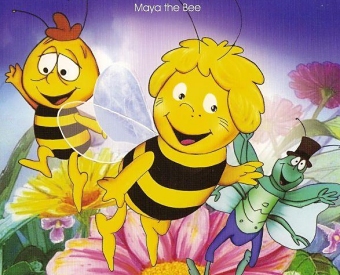
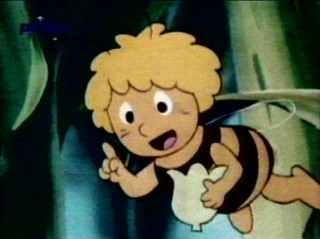
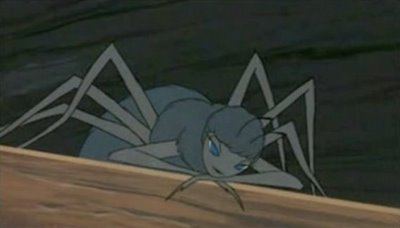
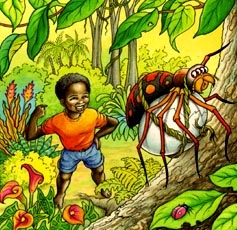
Funny how mythical spiders are topping both the heroes and villains, though the devious Tsuchigumo is
probably less than a match for Anansi the Trickster, one of the most famous figures of African folklore and
easily among the biggest superstars of any mythology. Son of the sky god Nyame and the fertility goddess
Asase Ya, Anansi is famous for so many and varied adventures that the term "spider tales" can describe folk
tales of all sorts, with or without Anansi as a character, and the arachnid is even said to be the keeper of every
story in the world. Yes, every story. Whether it's a classic fairy-tale, a best-selling novel, events that you
personally experienced and are now recounting to your friends, or disquieting "fan fiction" about She-Hulk's
experimental teenage years, that story is simply being borrowed from Anansi, who keeps his unfathomably vast
collection in some sort of magical bag or box.
His own tales vary from humorous blunders to great acts of heroism, often with a final moral akin to the fables
of Aesop, and found their way to many other countries through the slave trade. In the Southern United States,
Anansi was distorted into the feminine "Aunt Nancy," his/her stories otherwise remaining fairly intact.
probably less than a match for Anansi the Trickster, one of the most famous figures of African folklore and
easily among the biggest superstars of any mythology. Son of the sky god Nyame and the fertility goddess
Asase Ya, Anansi is famous for so many and varied adventures that the term "spider tales" can describe folk
tales of all sorts, with or without Anansi as a character, and the arachnid is even said to be the keeper of every
story in the world. Yes, every story. Whether it's a classic fairy-tale, a best-selling novel, events that you
personally experienced and are now recounting to your friends, or disquieting "fan fiction" about She-Hulk's
experimental teenage years, that story is simply being borrowed from Anansi, who keeps his unfathomably vast
collection in some sort of magical bag or box.
His own tales vary from humorous blunders to great acts of heroism, often with a final moral akin to the fables
of Aesop, and found their way to many other countries through the slave trade. In the Southern United States,
Anansi was distorted into the feminine "Aunt Nancy," his/her stories otherwise remaining fairly intact.
